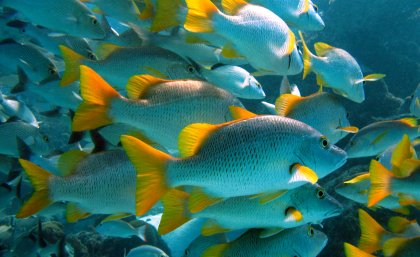.jpg?itok=h4UUCpLR)
A widespread lack of funds and personnel are preventing protected marine areas from reaching their full potential, a new global study involving University of Queensland research has revealed.
Co-author Professor Peter Mumby of UQ’s School of Biological Sciences said only nine per cent of marine protected areas (MPAs) reported having adequate staff and only 35 per cent reported acceptable funding levels.
“Despite this, MPAs are an increasingly popular strategy for protecting marine biodiversity,” he said.
Professor Mumby said, after four years compiling and analysing data on site management and fish populations in 589 MPAs around the world, researchers discovered shortfalls in staffing and funding were hindering the recovery of MPA fish populations.
Lead researcher Dr David Gill, conducted the study during a postdoctoral fellowship supported by the National Socio-Environmental Synthesis Center (SESYNC) in Maryland, and the Luc Hoffmann Institute, Switzerland.
He said the study identified critical gaps in the effectiveness and equity of marine protected areas.
While fish populations grew in 71 per cent of MPAs studied, the level of recovery of fish was strongly linked to management of sites.
At MPAs with sufficient staffing, increases in fish populations were nearly three times greater than those without adequate personnel.
“We set out to understand how well marine protected areas were performing and why some performed better than others,” Dr Gill said.
“What we found was that while most MPAs increased fish populations, including some that allowed limited fishing activity, increases were far greater in MPAs with adequate staff and budget.”
Marine protected areas have rapidly expanded in number and total area around the world.
In 2011, 193 countries committed themselves to the Convention on Biological Diversity Aichi Targets, including a goal of “effectively and equitably” managing 10 per cent of their coastal and marine areas within MPAs and “other effective area-based conservation measures” by 2020.
In the past two years alone, more than 2.6 million km2 have been added to the portion of the global ocean covered by MPAs, bringing the total to more than 14.9 million km2.
To address the issue of MPAs delivering ecological and social benefits, the authors propose policy solutions including increasing investments in MPA management, prioritising social science research on MPAs, and strengthening the methods for monitoring and evaluation of MPAs.
The research paper Capacity shortfalls hinder the performance of marine protected areas globally is published in Nature.
Media: Professor Peter Mumby, p.j.mumby@uq.edu.au. SESYNC Science Communications Coordinator, Emily Cassidy ecassidy@sesync.org, +1 410 919 4990.
.jpg)



